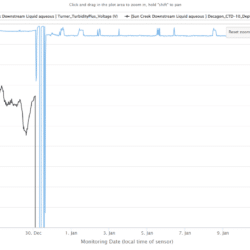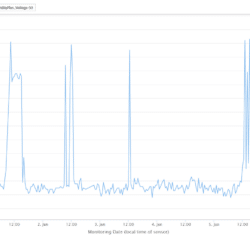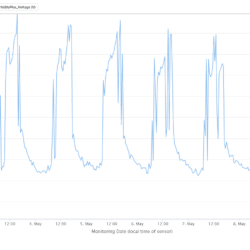Home › Forums › Mayfly Data Logger › Curious sensor failures and cyclical measurements
- This topic has 1 reply, 2 voices, and was last updated 2023-05-22 at 4:33 PM by
 Shannon Hicks.
Shannon Hicks.
-
AuthorPosts
-
-
2023-05-18 at 11:15 AM #17826Curious sensor failures and cyclical measurements
We have a station with HYDROS-21 and Turner Turbidity+ sensors. Beginnin
Curious sensor failures and cyclical measurementsWe have a station with HYDROS-21 and Turner Turbidity+ sensors. Beginning on 12/30/22 the HYDROS appears to have quit communicating, reporting only values of -9999 for all its variables. Near the same time, the Turner began reporting values with a daily cyclical pattern: higher in midday, and lower at night. Field inspection of both sensors and the Mayfly revealed no apparent cabling or other physical problems or damage. The Mayfly was also power-cycled at that time, with no change in results.
The Turner reports its turbidity measurement as a voltage, 0-5V, from which we calculate NTU using the manufacturer’s formula. Both voltage and NTU are posted to MMW. The Turner’s signal+ and signal- leads are wired to a voltage divider on an EnviroDIY Grove screw terminal adapter so that it doesn’t exceed Mayfly’s 3.3V. (This thread has a description of the circuit.) During the daily cycles, the Turner’s voltage ranges roughly from 0.012 – 0.030V, which translate to an NTU range of -1 to 10.
Given the daily oscillations in the Turner’s voltage readings, I began wondering whether the solar input is affecting reference voltage somehow: higher battery voltage correlating to higher Turner voltage. Digging further, I realized that this particular station was mis-wired when first deployed in April 2022: The 6W 6V Voltaic solar panel was connected to one of the BAT terminals on the Mayfly, rather than the SOLAR terminal, causing the reported battery voltage reached as high as 7.8V. (Discovered and resolved in this thread.) This was corrected at the next field visit (2 weeks later), and the Mayfly began reporting reasonable values for all variables, and appeared to work properly until the change on 12/30.
Is it possible that the Mayfly was damaged somehow (voltage regulation?), but only manifested some months later? Could that also affect the SDI12 circuitry, and thus prohibit communicating with the HYDROS-21? Any suggestions for additional troubleshooting or other ideas would be appreciated!
[EDIT] I’ve added some plots to show 1) the shift in both sensors’ values on December 30th, 2) Turner voltage cycling in January, and 3) Turner voltage cycling in May. Comparing January to May reveals a change in length and timing of reported Turner voltage, presumably corresponding with the seasonal shift in insolation length and timing.
Thanks,
Matt
Trout Unlimited -
2023-05-22 at 4:33 PM #17837Have you tried disconnecting one sensor at a time and seeing how the other one performs? We’ve found that sometimes when one sensors fails or “goes bad”, it can cause erratic readiHave you tried disconnecting one sensor at a time and seeing how the other one performs? We’ve found that sometimes when one sensors fails or “goes bad”, it can cause erratic readings or performance of any other sensor that’s also connected. By unplugging each sensor independently, it’s usually easy to isolate which sensor was the actual culprit, and which one was just affect by having the bad one connected at the same time (usually because of excess current draw or electrical noise).
-
-
AuthorPosts
- You must be logged in to reply to this topic.

 Welcome to EnviroDIY, a community for do-it-yourself environmental science and monitoring. EnviroDIY is part of
Welcome to EnviroDIY, a community for do-it-yourself environmental science and monitoring. EnviroDIY is part of 

